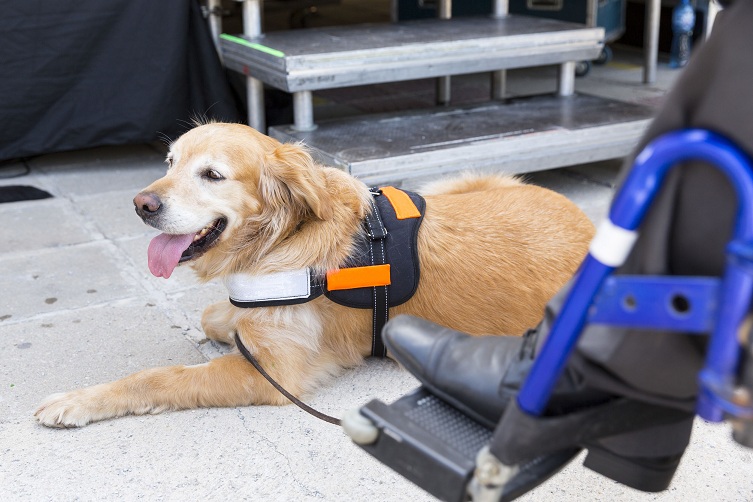
When most people think of Service Dogs, they think of seeing eye dogs, or guide Dogs. But in reality, Service Dogs help hundreds of thousands of people with a range of disabilities in the U.S. lead better lives.
Having a Service Dog is a right protected under federal law by the Americans With Disabilities Act (ADA). A person having a disability is defined by the ADA as “an individual having a physical or mental impairment that substantially limits one or more major life activities, an individual having a previous history or account of such a damage, or an individual who is supposed by others as having such an impairment.” By definition, a Service Dog is a dog that has been trained to help someone with a disability.
Service Dogs significantly improve the lives of their handlers by helping them with tasks they otherwise would not be able to perform. If you’ve anytime considered making your dog a service dog, the first step is to understand the regulations regarding assistance animals. This step by step guide will teach you how to make your dog a service dog.
If you have a disability or illness, you can train your dog to assist you. Service dogs can help people with the following conditions:
● Mobility Issues
● Blindness
● Hearing Loss
● Diabetes
● Multiple Sclerosis (MS)
● Cancer
● Autism
● Epilepsy
● Osteoporosis
● Scoliosis
● Narcolepsy
● Post-Traumatic Stress Disorder
The following kinds of Service Dogs perform tasks to help their humans:
● Guide Dog
● Hearing Alert Dog
● Mobility Aid Dog
● Seizure Alert Dog
● Seizure Response Dog
● Anxiety Service Dog
● PTSD Service Dog
● Diabetic Alert Dog
● Medical Alert Dog
● Migraine Alert Dog
● Narcolepsy Alert Dog
● Psychiatric Service Dog
● Autism Service Dog
● Allergy Alert Dog
1. Train Your Dog to Be a Service Dog
The first step in the process of making your dog a Service Dog is to train your dog. It is allowed under law for you to train your household pet to become your Service Dog – no matter the breed! The ADA does not restrict based on dog breed or weight. Your dog just needs to be healthy and past the puppy phase.
Training your dog takes knowledge, time, and patience. You can either train your dog yourself or hire a professional to do so. Alternatively, you can adopt a trained Service Dog from a reputable trainer. The U.S. has no official regulations regarding the duration of training for Service Dogs, but international standards suggest about 120 hours over the course of six months – 30 hours of which are recommended to be in public to help dogs deal with distractions.
In order to qualify as a Service Dog, your dog will need to follow basic obedience tasks such as responding to commands like “Sit” and “Stay.” They must also behave in public, which means no begging, barking, or jumping. The idea is that the dog’s attention and behavior needs to be focused on their handler.
2. Register Your Dog as a Service Dog
The next step is to register your dog with a Service Dog registry. Registration greatly simplifies the life of someone with a Service Dog. With a Service dog vest, tag, and ID card, your dog will be easily identified by others. Visual markers that your dog is working while with you help cut down on unnecessary, tiresome questions from the public when you try to travel or enter buildings with your Service Dog.

Besides the performance of necessary tasks and the potential life-saving assistance of a Service Dog, there are other benefits to making your dog a Service Dog. According to the ADA, you can live with your dog any place, including places that have no-pet policies. You can also travel with your dog anywhere.
Under the ADA, you are allowed to go with your Service Dog anywhere the general public is allowed to go – that’s something all state and local governments, businesses, and non-profit organizations must abide by. Additionally, The Air Carrier Access Act (ACAA) grants you the ability to travel with your Service Dog on an airplane, but it’s important to check with your airline regarding details prior to flying.
Additionally, a public accommodation or facility is not allowed to ask for documentation or proof that your dog has been certified, trained, or licensed as a service animal. Under law, they can only ask if your dog is a Service Dog and what tasks the dog performs for your disability. However, having documentation can cut down on a lot of hassle and having a labeled Service Dog Vest can cut out the conversation altogether.
The ADA also protects your right to bring your Service Dog to work. Your employer must make reasonable accommodations for you and your dog, such as allowing for walk breaks and adequate space.
If you’re ready to make your life easier, register your dog as a service dog today. USA Service Dogs offers fast, easy, and 100% compliant online registration. Register and get your Service Dog ID Kit, Vest and more in just minutes. As the highest rated service dog registry, with over 13,000 5-star reviews, they’re a reputable company you can trust.